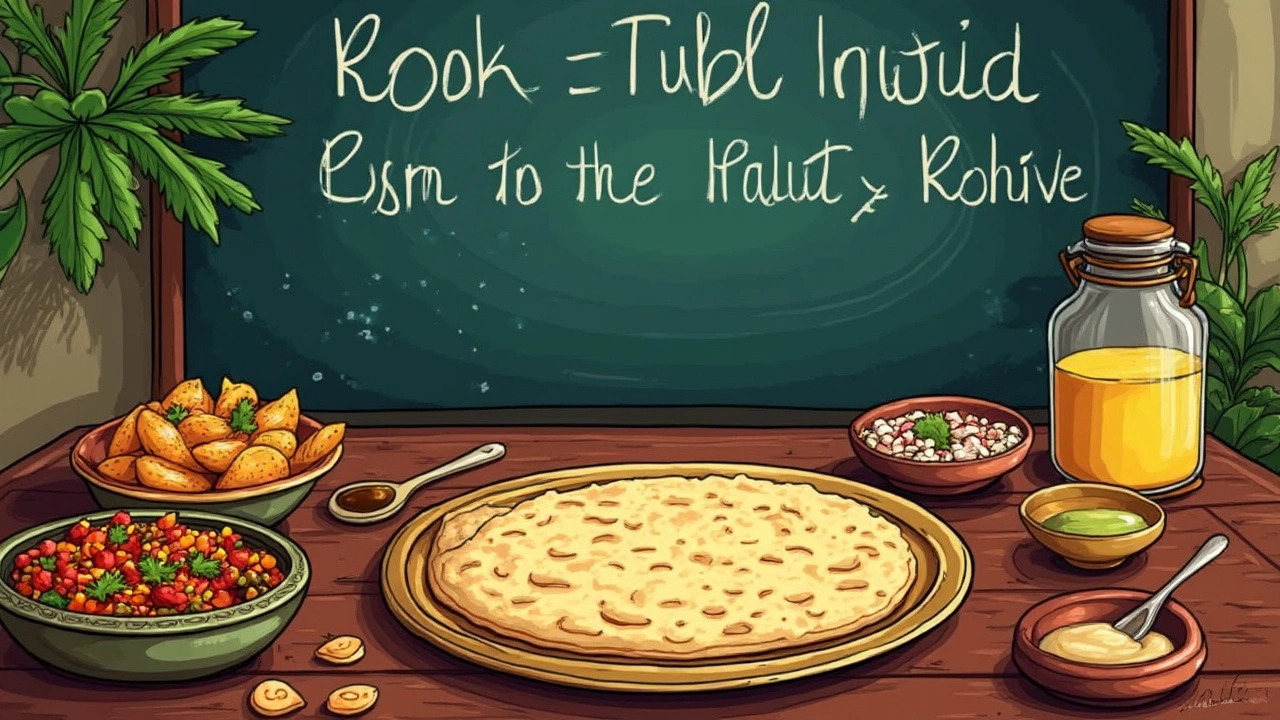How to Make Low-Calorie Roti at Home: Keeping Calories in Check
 Feb, 17 2025
Feb, 17 2025
Ever wondered how much calories are lurking in your everyday roti? On average, a single plain roti contains about 70-100 calories, depending on its size and ingredients. Planning to slather it with ghee? Well, that adds an extra 40 calories per teaspoon. Throw in some sabzi, and your entire meal can easily cross 200 calories if you're not careful.
But don't worry! It's possible to enjoy this staple without tipping your calorie count over the edge. Making low-calorie roti at home isn't just healthier, it's simpler than you might think. With the right tweaks and tips, you can craft a delicious roti that fits perfectly into a balanced diet.
- Understanding Calorie Count
- Ingredients and Tools You’ll Need
- Step-by-Step Guide to Make Low-Calorie Roti
- Tips to Keep Your Meal Healthy
Understanding Calorie Count
When it comes to making healthier choices, understanding the calorie count in what we eat is crucial. So, how many calories in 1 roti? The truth is, a regular roti cooked from whole wheat flour typically contains about 70-100 calories. But why the range? Factors like thickness, size, and how it's cooked can vary the numbers.
Add a bit of ghee? Calories in 1 roti with ghee jump up, tacking on about 40 extra calories for every teaspoon. Planning to have it with a serving of sabzi? When you combine calories in 1 roti and sabzi, the count easily extends beyond 200 calories per meal, depending on the richness of the preparation.
The Importance of Portion Control
Portion control is your first step to managing these numbers. It's easy to enjoy rotis in moderation by slightly reducing the size or opting for lightweight servings. For instance, a thinner, smaller roti can help you shave calories without feeling deprived.
Making Calorie-Friendly Choices
- Opt for whole grains: These are not only better for your health but also keep you fuller for longer.
- Watch the extras: Keep ghee and butter to a minimum if you're aiming to lower the calorie count.
- Load up on veggies: Adding more sabzi boosts nutrients while keeping calories in check.
By keeping an eye on these variables, you'll never have to wonder how much calories in 1 roti can vary with different additions again. Awareness is your cheat sheet to a guilt-free dining experience.
Ingredients and Tools You’ll Need
Before we roll up our sleeves and dive into making a low-calorie roti, let's gather everything we need. Having the right ingredients and tools not only makes the process smoother but also helps ensure you're making a healthier version of this popular dish.
Key Ingredients
The star of our show is the whole wheat flour. Unlike refined flour, whole wheat is packed with fiber and keeps you feeling full longer. A cup of whole wheat flour contains about 400 calories but provides important nutrients.
“Whole grain is a key component of a balanced diet and supports digestive health,” says Dr. Priya Sharma, a nutritionist known for advocating whole foods.
- Water: Essential for kneading the dough. Start with half a cup and adjust as needed.
- Olive oil or a low-calorie substitute: Use about 1 teaspoon to help bring the dough together.
- Salt: Just a pinch to enhance flavor without upping calorie count.
Tools of the Trade
Next, let’s talk about the tools you want on your side:
- Rolling pin: For evenly flattening the dough, ensuring even cooking and consistent calories in roti size.
- Tawa or flat griddle: A non-stick one keeps you away from unnecessary oil or butter.
- Mixing bowl: Ideal for bringing your ingredients together smoothly.
Armed with the right ingredients and tools, you're well on your way to enjoying a delicious and low-calorie roti without compromise. Ready to create your own healthy masterpiece?

Step-by-Step Guide to Make Low-Calorie Roti
Creating a low-calorie roti isn’t just about cutting back on ingredients; it’s about making smarter choices. Here's how you can make your everyday roti lighter on calories without giving up on taste or texture.
1. Choose the Right Flour
Whole wheat flour is a great start. It’s more filling and has more fiber than refined flour. For extra nutritional value, mix in some oat flour or almond flour. These tweaks not only reduce the calories in roti but also add a nutritional kick.
2. Measure Ingredients Accurately
Start with 1 cup of your mixed flour. Add a pinch of salt and about a half cup of water, but add water slowly—just enough to form a soft dough. Remember, the less water you use, the better your low-calorie roti will roll out without sticking.
3. Getting the Dough Just Right
Knead the dough well, but don’t stress. It should be smooth but not sticky. Let it sit for about 10-15 minutes. This rest period helps in making the rotis softer and easier to roll out, reducing the need for extra flour, which means fewer calories.
4. Rolling and Cooking
- Divide the dough into equal balls, roughly the size of a golf ball.
- Lightly dust your rolling area with the flour mix.
- Roll each ball into a thin, circular shape.
- Heat a non-stick pan on medium-high flame. Cook each side of the roti until it puffs up slightly and gets light brown spots.
- No oil is necessary. If you must use ghee, do so sparingly.
5. Optional Final Touch
For a slightly richer flavor without too many extra calories in 1 roti with ghee, you can lightly brush with ghee right after removing from heat. Just remember, moderation is key!
Simple, right? Keeping an eye on ingredients and cooking methods ensures you don't exceed the calories in 1 roti, making it easier to maintain a balanced diet. So next time you're in the kitchen, you know how to keep the meal light and healthy!
Tips to Keep Your Meal Healthy
Eating healthy doesn't mean you have to sacrifice flavor or satisfaction. Here are some practical tips to ensure your roti meals are both delicious and low in calories.
Watch Your Portions
Overeating even the healthiest foods can lead to consuming more calories in roti than intended. Stick to a single roti or smaller-sized servings to keep calorie intake in check. Sharing meals or saving leftovers for another time can also help.
Choose Whole Grains
Opting for whole wheat atta instead of refined flour can boost fiber intake, keeping you fuller for longer. This helps manage the hunger pangs without the added calories. Plus, whole grains are great for digestion and overall health.
Skip the Ghee
While adding ghee can enhance the flavor, it also adds extra calories. If you can't resist, try spraying a little non-stick cooking spray as a low-calorie alternative to the usual dollop of ghee. This small change can make a big difference when considering calories in 1 roti with ghee.
Pair with Nutritious Sabzi
When considering calories in 1 roti and sabzi, choose recipes loaded with veggies rather than a potato-heavy dish. Vegetables like spinach, broccoli, and bell peppers are nutrient-rich and help keep the calorie count down.
Stay Hydrated
Sometimes, we mistake thirst for hunger. Before you reach for another roti, drink a glass of water. Staying hydrated can help control unnecessary calorie intake and is great for overall well-being.
Stats on Common Additives
| Additive | Calories Added |
|---|---|
| 1 tsp of ghee | 40 |
| 1 tbsp of oil | 120 |
| Average sabzi portion | 30-50 |
With these tips, you can enjoy the taste and comfort of your home-cooked meals without compromising your health goals. A few adjustments in preparation can go a long way in keeping your calorie intake in check.